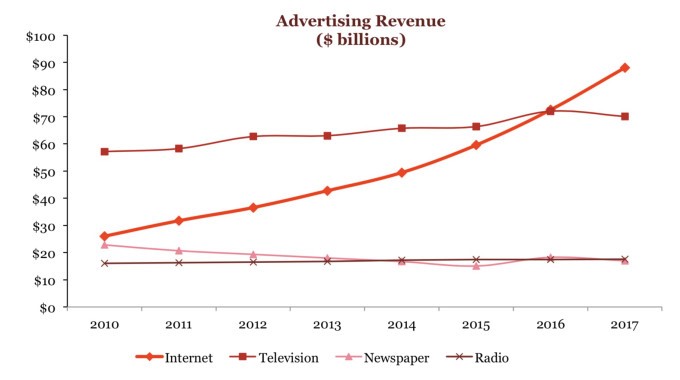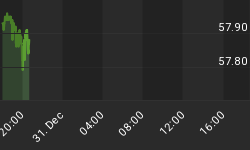It's been a long time coming, but online and digital advertising has finally crossed a remarkable milestone-- taking the crown from traditional TV as the most preferred platform by marketers.
Online advertising revenues clocked in at $88 billion in 2017, a 21-percent increase compared to a year earlier, according to an IAB Internet Advertising Revenue Report. That marked the first time that digital ad spend surpassed broadcast and cable TV ad revenue ($70.1 billion).

(Click to enlarge)
Source: TechCrunch
The whole gamut of the digital universe posted impressive double-digit growth.
Mobile advertising continued its meteoric rise, climbing 36 percent year-over-year to $49.9 billion and contributing an even bigger piece of the digital ad pie--57 percent of the total.
Total digital video (desktop and mobile) was up 33 percent to $11.9 billion with mobile video increasing at a brisk 54-percent clip to $6.2 billion.
Social media ad spend was up 36 percent to $22.2 billion while digital audio grew 39 percent to $1.6 billion. Even the much-scorned banner and search ads were up a healthy 23-and-18 percent, respectively.
According to PwC US Partner David Silverman, the switch-up from cable to online was driven by improvements in technology, the rise of self-serve platforms for smaller businesses, growing use of brands that sell directly to consumers and the ability of online ads to target large-scale audiences.
Video Gold
Google and Facebook are effectively a duopoly in the digital ad space, gobbling up nearly 60 percent of ad dollars while no other platform commands more than 5 percent. Both companies rely heavily on video ads, with Google's YouTube being the largest social media video platform, while Facebook's original videos have been getting strong traction. Related: Tech Giants Race For Credit Card Dominance
The sheer dominance of the two has left the other owners of digital ad inventory feeling squeezed. Consumer advocates have been constantly worrying about the giants snuffing out competition with EU regulators placing them under close scrutiny. But size and the ability to quash rivals does not necessarily constitute anti-competitive behavior, and both companies are likely to continue hogging the digital spotlight for years to come.
Meanwhile, streaming video platforms such as Netflix, Hulu, Amazon Prime Video and, more recently, ESPN streaming, continue to nip at the heels of traditional broadcast TV and cable. It's estimated that Netflix alone cost TV advertisers as much as $6 billion every year in lost ad opportunities.
Pay TV's Going Nowhere
In the same vein, it's important to avoid confusing popular opinion with facts. It's not like TV is about to die suddenly--TV ad spending is mostly flat or growing slowly depending on the period under review.
Related: Trump Backtracks On Big Pharma Crackdown
It's just that digital media including mobile, video streaming and social media are growing much faster.
Looking at a global perspective, digital ads are expected to grow at a healthy 13-percent compound annual growth to reach $237 billion by 2020, while TV ads are only expected to grow at a more modest 2.5 percent to reach $183 billion over the period.
Despite the gradual decline in Pay TV revenues due to cord-cutting and cord-trimming as well as the popularity of skinny bundles and DVRs, cable TV is likely to remain relevant in the foreseeable future. Indeed, a PwC study has revealed that 73 percent of consumers still own a PayTV subscription but a staggering 82 percent of them would cut the cord if it weren't for sports.
For those who feel frustrated by their cable company but aren't necessarily looking to cut the cord, here are a few tips to downsize your bill.
By Alex Kimani for Safehaven.com
More Top Reads From Safehaven.com:

















